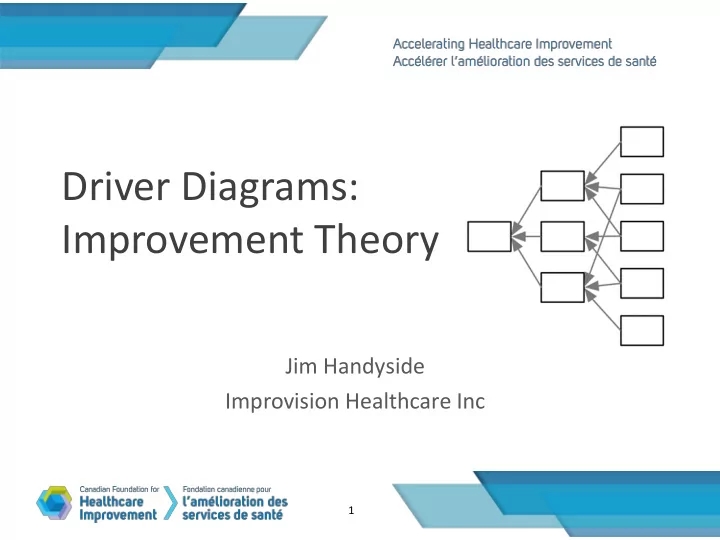

Driver Diagrams: Improvement Theory Jim Handyside Improvision Healthcare Inc 1
Purpose • To become familiar with driver diagrams. • To recognize the input required for the development of improvement theory. • Differentiate the driver diagram from other similar planning and improvement tools. 2
Why Theory? Effective change is not a “black box”. ? A new process, system, Improvement culture… Aim 3
A “simple” personal improvement Better physical health Improve my health and well being Better mental health 4
A “simple” personal improvement Consume less Better physical health Reduce Weight Burn more Better mental health 5
A “simple” personal improvement theory Consume less Measure (app) Standing Desk Reduce Change Daily Weight routine Walk to work Burn more Start Return to sport Exercise Lunch time walks 6
My improvement project Consume less Measure (app) Standing Desk Reduce Change Daily Weight routine Walk to work Burn more Return to sport Start Exercise Lunch time walks 7
A simplified quality improvement Risk Identification Multifactorial risk assessment Reduce falls resulting in Multifactorial 45 change 10 secondary harm by 50% interventions ideas and drivers concepts Communication of fall risk status Education of staff, patient, and family/carer Ref: Falls Prevention Driver Diagram and Change Package NHS 8
“Experience by itself teaches nothing… Without theory, experience has no meaning.” W. Edwards Deming (from: The New Economics ) 9
Theory Definition (Oxford English Dictionary) A supposition or a system of ideas in intended to explain something… An idea used to account for a situation or justify a course of action. 10
Two kinds of causal theory diagrams : Fishbone: Driver Diagram: Team theories about what Team theories about what IS causing an effect. changes WILL result in improvement. Account for Justify present situation action (change) 11
Anatomy of Driver Diagram Direction of Improvement cause or Aim influence Change Ideas Primary Secondary Drivers Drivers 12 See article: What’s Your Theory
Change is an expression of theory Action Change ideas: Process Eliminate waste Knowledge, skill Behavior Technology Etc. Thinking (bundle) 13
build theory HOW HOW HOW AIM HOW HOW HOW 14
WHY WHY WHY AIM WHY WHY WHY Rationale for change 15
Careful with your logic… Is education a secondary driver? Risk Identification Multifactorial risk assessment Reduce falls Education of staff, resulting in patient, and Multifactorial harm by 50% family/carer interventions Communication of fall risk status Ref: Falls Prevention Driver Diagram and Change Package NHS 16
Work Breakdown Structure (type of tree diagram) Project Management 17
Work Breakdown Structure Project Name B: PDSA C: New/Improved A: Planning Implementation Process Deliverables A1: Charter & Other B1: Information B2: Recruited C1: Lessons C2: New Standard Planning Docs Package Sites Learned Process A2: Driver B3: Prepared B4: Designed & C3: Plan for C4: Implemented & Diagram Sites Test PDSAs Spread Spread Process B6: Analyzed A3:Implementa- B5: Implement Outcomes tion Plan* PDSA(s) QI Project schematic 18 Ref: Alison Paprica, PhD, PMP
Your theory, driver diagram and PDSA 19
PDSA to develop/test change AND confirm or adjust theory 20
You need measurement to test theory 21
Improvement theory inputs 1. Evidence 2. Experience 3. Other’s improvement 4. Analysis of your current state …… 22
Getting started: Sticky note exercise 1. Compile inputs: • Evidence • Experience • Other’s improvement • Analysis of current situation 2. Sort, organize build primary and secondary drivers Or use a template document DRAFT! (it’s a draft until you know what worked or didn’t and why.) 23
Thank You! Two articles: What’s Your Theory? Demystifying Theory and Its Use In Improvement cfhi-fcass.ca | @CFHI_FCASS
Recommend
More recommend